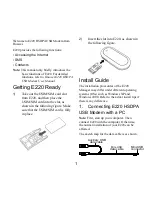
Network Communication
HopNet Family of Products
800281Rev. B
40
Network Communication
Introduction
This section provides information on how HopNet products communicate with each
other.
Synchronizing the Base with the Remotes
The base station establishes the network timing by sending out a synchronization
pulse at the beginning of each hop. The remotes first scan for this pulse and
synchronize to the base hopping pattern before they can communicate. This timing
acquisition may take about 2 seconds. Once synchronized, the remote unit will
request registration from the base station. The registration process identifies to the
base station the remotes from which transmissions will be received and not
discarded. Registration also allows tracking of remotes entering and leaving the
network. DCD is used to indicate that a remote has established lock. Should a
remote unit go out of range of the base signal, it will then drop carrier detect after a
programmed number of hops and attempt to reacquire the signal. To detect if a
remote has gone offline or out of range, the registration must be renewed once every
255 hops. Registration is completely automatic and requires no user application
intervention.
When not transmitting or receiving, the remote unit automatically drops back to
standby current.
Data Transmission
The HopNet supports two network configurations: point-to-point and point-to-
multipoint. In a point-to-point network, one radio is set up as the base station and
the other radio is set up as a remote. In a point-to-multipoint network, a star
topology is used with the radio set up as a base station acting as the central
communications point and all other radios in the network set up as remotes. In this
configuration, all communications take place between the base station and any one
of the remotes. Remotes cannot communicate directly with each other. It should be
noted that point-to-point mode is a subset of point-to-multipoint mode and therefore
there is no need to specify one mode or the other.
Summary of Contents for HopNet 10 Series
Page 8: ...This page intentionally left blank...
Page 46: ...This Page Intentionally Left Blank...
Page 64: ...56 This page intentionally left blank...
Page 82: ...This page intentionally left blank...
Page 88: ...This page intentionally left blank...
Page 90: ...HN 1510 HopNet Family of Products 800281 Rev B A 2 HN 1510...
Page 91: ...HN 2010 800281 Rev B HopNet Family of Products A 3 HN 2010...
Page 92: ...HN 3500 HopNet Family of Products 800281 Rev B A 4 HN 3500...
Page 93: ...HN 3010 800281 Rev B HopNet Family of Products A 5 HN 3010...
Page 94: ...HN 1010 HopNet Family of Products 800281 Rev B A 6 HN 1010...
Page 95: ...This page intentionally left blank...
Page 96: ...This page intentionally left blank...
Page 98: ...HopNet Family of Products 800281 Rev B B 2 Jumper Configuration of HN 3010...
Page 99: ...This page intentionally left blank...
Page 100: ...This page intentionally left blank...
















































